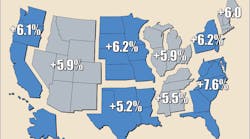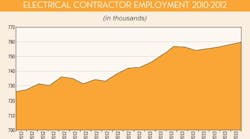Continued strength in several key segments of the construction market should position 2015 for some solid growth.
If a few key market drivers kick into gear, we may look back at 2015 as the Good Old Days for the U.S. electrical construction market. Inflation and interest rates are low. Office construction is starting to pick up in many markets and single-family housing may finally be ready for a few good years of growth. While the deep drop in oil and gas prices are starting to bring some pain to companies that rely on revenues from the energy sector, it’s been a blessing to most businesses and consumers. Buoyed by construction of massive petrochemical facilities, the industrial market appears to be poised for steady growth and is starting to enjoy the low prices that come with the current abundance of domestic natural gas. And local, state and federal spending on schools, universities and other public buildings may finally become a reality again in 2015 after a long hiatus.
Few countries on the planet now enjoy such a perfect storm of positive economic indicators. Indeed, one of the few negatives in the 2015 U.S. economic outlook is that key trading partners are wrestling with reduced growth rates (China), or are worried about falling back into recession (Europe). It really is pretty amazing how far the overall U.S. economy has come back since the Great Recession of 2007-2009.
But while many of the national economic indicators point toward another year of steady growth, not all metropolitan areas will share equally in this prosperity. You could make an argument that the U.S. appears to be evolving into a land of haves and have-nots, with some cities and states enjoying population increases, job growth, low unemployment and diversifying economies, while other regions of the country lose population and struggle to attract new businesses. Attracting new residents and businesses are cities or metropolitan areas like Boston; New York; San Francisco-Silicon Valley; Washington, D.C.; Charlotte, and Raleigh, N.C.; Austin, Dallas, Houston and San Antonio, Texas; and Seattle. On the flip side, some Rust Belt cities like Detroit, the Cleveland-Akron area and a large handful of mid-sized cities in the Industrial Midwest, upstate New York, western Pennsylvania, and in some areas of the rural South continue to lose residents.
While all business is ultimately local, it’s important to also consider the national perspective when developing your annual forecasts. Electrical Wholesaling’s annual National Factbook, which has evolved into one of the magazine’s most popular features, will help you identify some of market drivers that we think will have the most impact on the overall electrical market in 2015.










